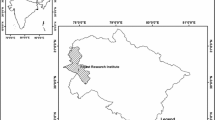Abstract
The information on evaporation has become important during the last decades because of monitoring and management of water resources and crop water requirement. The principal weather variables affecting evaporation are radiation, air temperature, humidity, rainfall and wind speed. Models or procedures have been developed to assess the evaporation from weather variables; it is mainly based on regression models (linear and nonlinear) in studying relationship of evaporation with weather variables (as such or in some transformed forms). Nowadays, artificial neural networks (ANNs) techniques have become very popular because of their wide range of applicability and the ease with which they can treat complex problems even if the data are vague and noisy. From modeling perception, neural networks are interesting because of their potential use in prediction. This approach has been illustrated for prediction of evaporation for four locations, viz. Maruteru (16.6269° N, 81.7389° E), Palampur (32.1109° N, 76.5363° E), Patancheru (17.5287° N, 78.2667° E) and Raipur (21.2514° N, 81.6296° E) based on fifteen years’ historical data. Consider the different lag period (4–6 weeks) on maximum and minimum temperature, relative humidity, basic sunshine hours and rainfall as the input variables and evaporation as the output variable. ANN models with back propagation as the learning algorithm with varying architecture of hidden layers (one and two) and varying neurons in hidden layers were developed. The developed models were validated for subsequent weeks (52 standard meteorological weeks) for different locations. On the basis of mean squared errors, ANN-based models with 2 layers each having 5 & 6 neurons in respective layers showed the most promising results for Maruteru, while in Palampur, Patancheru and Raipur, the 2L-5-6N, 2L-6-5N and 2L-5-5N architectures gave the best results.



Similar content being viewed by others
References
Chow VT, Maidment DR, Mays LW (1988) Applied hydrology. McGraw-Hill Book Co., New York
Gupta B (1992) Engineering hydrology. N.C, Jain
Hebb DO (1949) The organization of behavior. A neuropsychological theory. Wiley, New York
Hopfield JJ (1982) Neural network and physical system with emergent collective computational capabilities. Proc Natl Acad Sci USA 79:2554–2558
Klimasauskas CC (1991) Applying neural networks. Part 3: training a neural network. PC/AI Mag 5:20–24
Kumar M, Raghuwanshi NS, Singh R, Wallender WW, Pruitt WO (2002) Estimating evapotranspiration using artificial neural network. J Irri Drain Eng ASCE 128(4):224–233
Masters T (1993) Practical neural network recipes in C++. Academic Press, Cambridge
Mcculloch WS, Pitts W (1943) A logical calculus of the ideas immanent in nervous activity. Bull Math Biophys 5:115–133
Rosenblatt F (1958) The perceptron: A probabilistic model for information storage and organization in the brain’. Psychol Rev 65(6):386–408
Rumelhart DE, McClelland JL (1986) Parallel distributed processing: explorations in the microstructure of cognition. MIT Press, Cambridge
Singh R, Bishnoi OP, Ram N (1992) Relationship between evaporation from class “A” open pan evaporimeter and meteorological parameters at Hisar. Haryana Agric Univ J Res 22(2):97–98
Widrow B, Hoff ME (1960) Adaptive switching circuits, IRE WESCON convention record, 96-104
Zhang G, Patuwo BE, Hu MY (1998) Forecasting with artificial neural networks: the state of the art. Int J Forecast 14:35–62
Author information
Authors and Affiliations
Corresponding author
Additional information
Publisher's Note
Springer Nature remains neutral with regard to jurisdictional claims in published maps and institutional affiliations.
Rights and permissions
About this article
Cite this article
Batra, K., Gandhi, P. Neural Network-Based Prediction Model for Evaporation Using Weather Data. Agric Res 11, 123–128 (2022). https://doi.org/10.1007/s40003-021-00537-z
Received:
Accepted:
Published:
Issue Date:
DOI: https://doi.org/10.1007/s40003-021-00537-z




